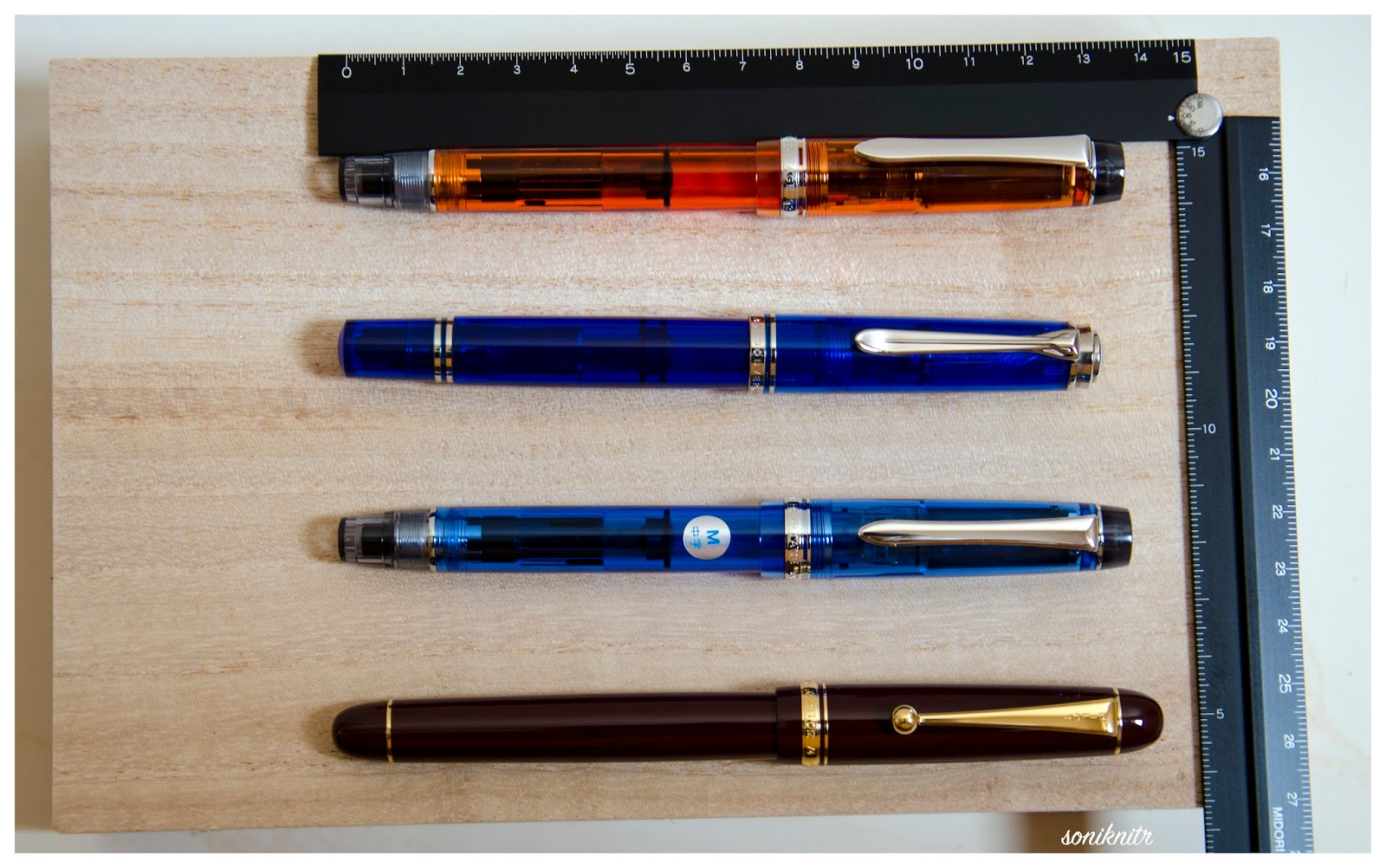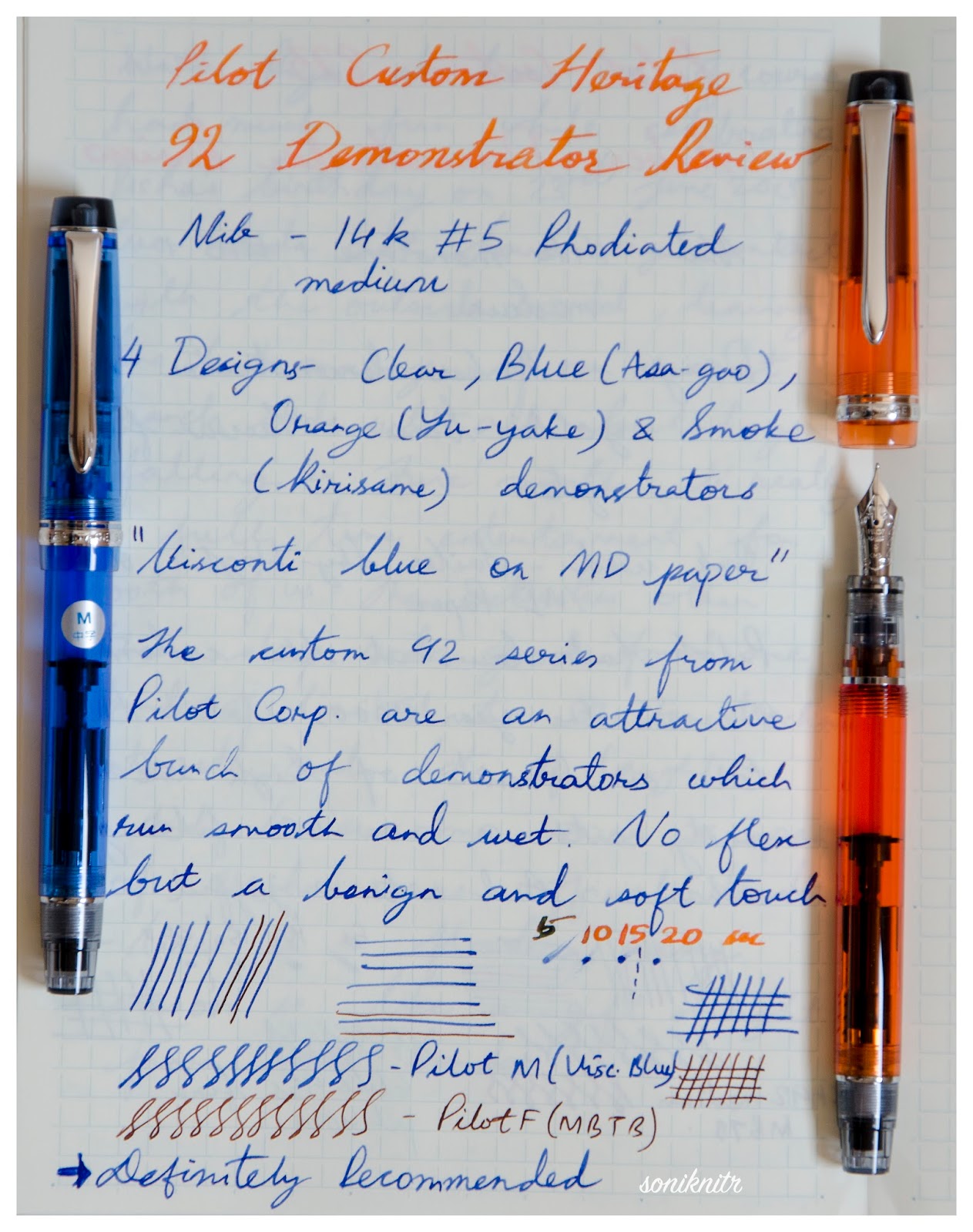I am not sure whether you too will get a Custom Heritage 92 (CH92) after falling intensely in love with a Custom 74 model. Many reviews do reveal this graduation of Pilot Love. Although my love for pilot pens can be absolutely blamed on genes. Initially, the CH92 were released as clear demonstrators around October 2010, sporting a #5 rhodiated nib. Since it was 92 years after the company’s inception (i.e. 1918), it does carry the first two digits of the model number as ‘92’ and the third digit which is by default ‘1’ usually refers price at launch of a pilot pen (i.e 1 X JPY 10,000). However, there is a minor deviation here, the price at launch was JPY 15,000, since the Custom 74 was already priced at JPY 10,000. The coloured versions were released two years later in 2012.
The CH92 (for the Asian market) comes packaged in a standard pilot gift box (Z-CR-GN) which may not be able to draw any attention, but the pen definitely does. I just fell in love with the ocean blue colour. The simplistic yet elegant design sustains the traditional functionalities in a modern garb. Definitely with the times, the ‘asa-gao’ ocean blue transparent body says everything about itself. Asagao refers to a bluish flower which is more commonly known as Japanese Morning Glory. It also comes in Sunset Orange (Yu-yake), Smoke (Kirisame) colours. The box carries a user manual for a Type S fountain pen.
DESIGN - THE COLOURED DEMONSTRATORS (6/6)
The CH92 comes in four standard designs of transparency - Blue, Orange, Smoke and Clear resin, all in silver trims. The resin material feels strong though not substantial like the Custom 823. Initially I went for the Asa-Gao Blue with medium nib which wrote beautifully, and I could not resist getting another. The second one was another Asa-Gao then a Yu-Yake Sunset Orange.
The demonstrators given their lightness, are capable of refracting even a tiny bit of light, while a silver shimmer running across the centre band along with the clip creates a photogenic contrast. The smoky finials at the cap along with the piston knob conclude its design.
The cap is light and unscrews with little more than a turn, revealing the dazzling nib. The grip section is moulded from the same smoky transparent resin as the finial (cap) and knob, with a metal ring segregating, the grip from the barrel. And its transparency does reveal the inside works of the piston mechanism.
The cap does mention a few things etched across a lower centre band, including the model name CUSTOM HERITAGE 92 and PILOT JAPAN. I somehow miss the stars in the other custom series pens. An apparently segregate band above (although its part of the centre band only), renders some differential aesthetics to the overall design. The clip is tension-fit and has the shape of the double-edged Japanese sword Tsurugi.
The subtle gradient created by the transparent body, along with the smoky black grip, finial (cap) and piston-knob sections converge the rhodium sheen to render a well-orchestrated symphony of colours. No component individually would seem as stupendous as the complete pen.
FILLING SYSTEM (6/6)
A small but remarkably efficient piston knob unscrews from the metal ring to a quick end stop. And it does go the distance when the knob is screwed back on by filling the barrel upto a volume of 1.2 - 1.3 mL. The outer connector of the piston mechanism consists of a metal unit fastened to a inner plastic unit, and it can be disengaged with a TWSBI wrench (7mm) as shown here by Hari. This helps add weight to pen and ensures that a metal wrench meets metal and thereby does not cause undue damage.
Cleaning the pen is a similar ritual accompanied by some shake. If there is some remnant ink left at the end of grip section, it’s an easy clean. You can repeatedly fill and flush the pen with the grip section dipped inside a bowl of water, or you can just remove the friction fit nib-unit and clean the insides with a soft damp cloth.
NIB - ALL THAT MATTERS (6/6)
The nib is friction-fit and comes in a standard 14k rhodiated design across four stock widths - F, FM, M & B. The nib has the standard pilot design.
The tail end of the nib specifies the month and year of manufacture. An elongated hexagonal imprint separates the design from the outer shoulders and tines with an arabesque decor running inside its circumference, encompassing the circular breather hole in between.
The branding and nib specifications of PILOT, 14k-585 (58.5% Au Alloy) along with the nib size and width, which are imprinted below the breather hole.
A standard bluish grey plastic feed with moderately spaced fins and a decently sized feeder hole delivers the amazing ink suction.
PHYSICS OF IT (5/6) – RELATIVELY SPEAKING
With a translucent resin body in form of a truncated cigar, it does give a comfortable feel of posted length. The cap weighs 8 grams. It’s a comfortable grip section with around 1 cm diameter. Un-posted, its gives a lacking feeling of both length and weight.
- Uncapped Length ~ 12 cm
- Posted Length ~ 15 cm
- Nib Leverage ~ 1.9 cm
- Overall Weight ~ 20 g
Capped, uncapped and posted comparisons with a few similar pens like the Custom 74 and the Pelikan m605 go below for your reference.
ECONOMIC VALUE(6/6)
The CH92 retails at around USD 220, and as usual it’s available at lower street prices towards a band of USD 130-140. I had bought the first pen at a cost of USD 130, and the subsequent ones at lower prices. Since pilot has stopped production of these coloured versions for some time now (as per two Japanese retailers), online retailers are selling off their leftover stock quite cheaply, getting as low as USD 110, to clear off old stock. May be Pilot is coming up with a new piston filler, who knows!
OVERALL (5.8/6)
This 14k nib has a smooth and wet flow. The nib is sturdy and does not have any line variation. It may lack the bit of softness and spring of a Custom 74 nib, but that’s purely my experience. There is absence of any significant variation among the horizontal and vertical strokes. These wet lines take almost 15 secs to dry a Visconti Blue Ink on MD paper.
Thank you for going through the review. Hope you enjoyed it.
More pen and paraphernalia reviews here.
More pen and paraphernalia reviews here.













